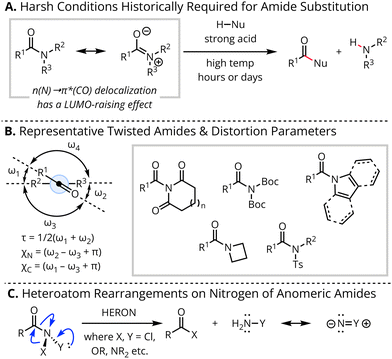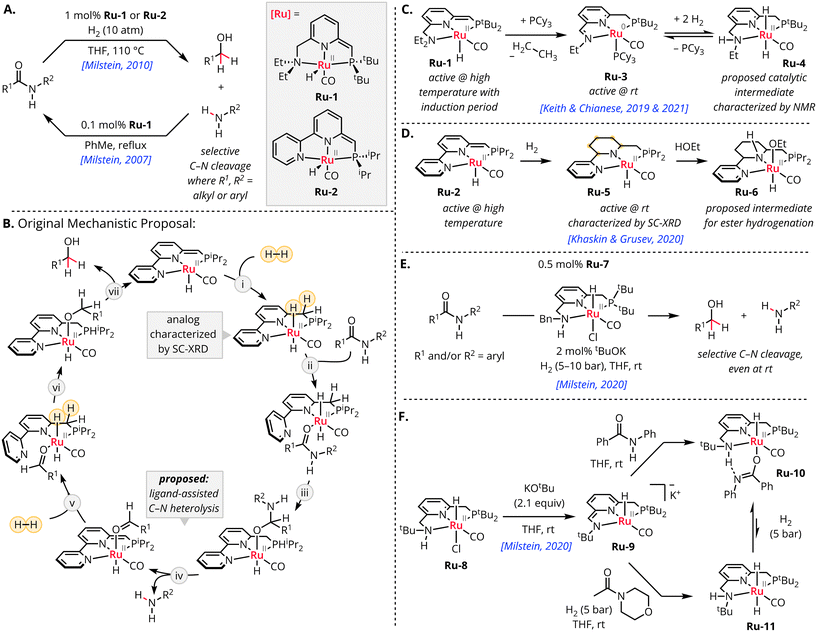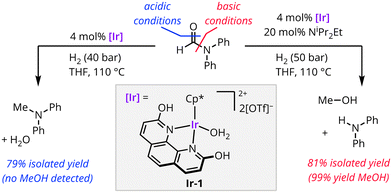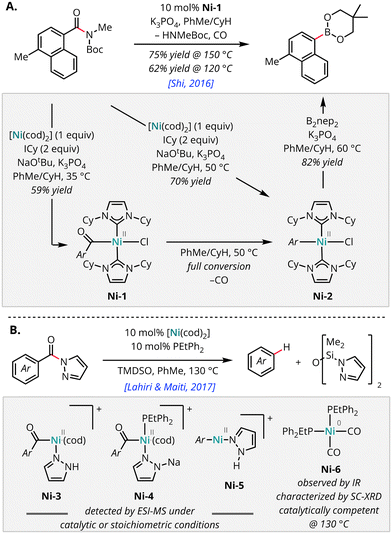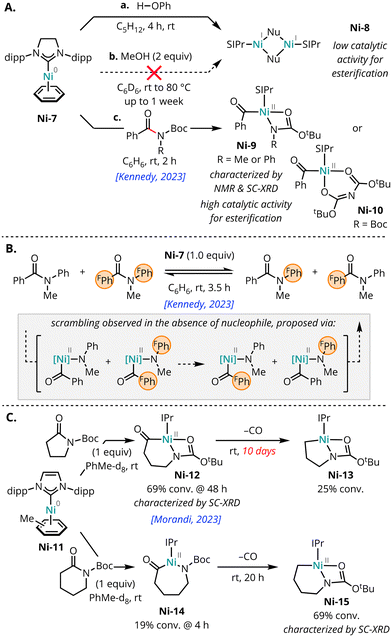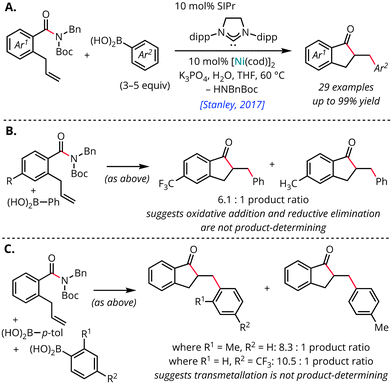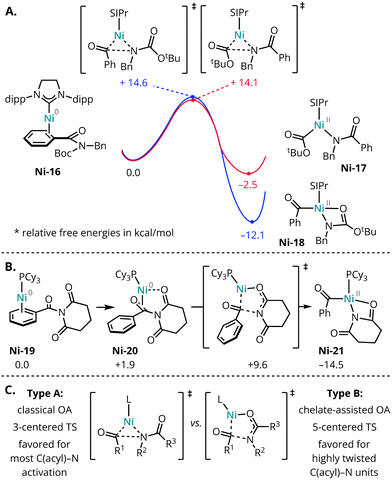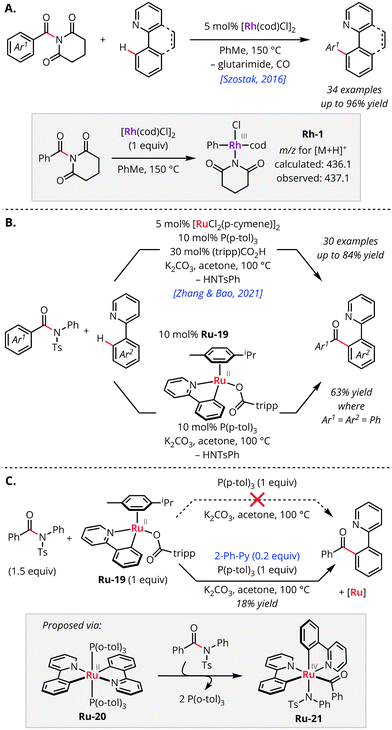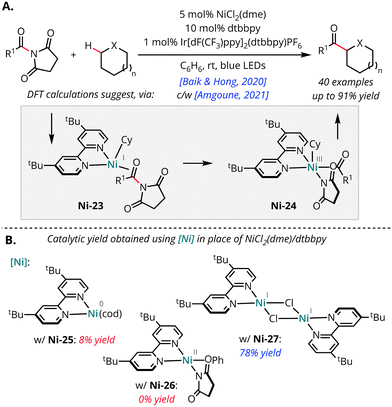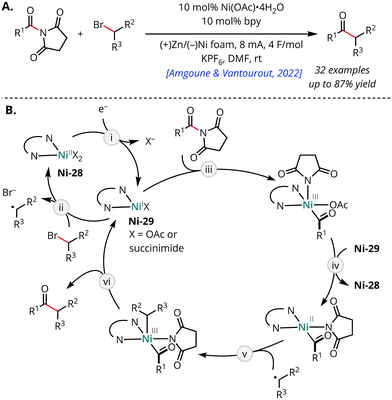Mechanistic insights on C(acyl)–N functionalisation mediated by late transition metals
Vivek G.
Pillai
 ,
Kaycie R.
Malyk
,
Kaycie R.
Malyk
 and
C. Rose
Kennedy
and
C. Rose
Kennedy
 *
*
Department of Chemistry, University of Rochester, Rochester, NY 14627, USA. E-mail: c.r.kennedy@rochester.edu
First published on 5th August 2024
Abstract
The carboxamide functional group has a privileged role in organic and biological chemistry due to its prevalence and utility across synthetic and natural products. Due to nN → π*CO delocalisation, amides and related functional groups are typically kinetically resistant to degradation. Nonetheless, over the past decade, transition metal catalysis has transformed our ability to utilise molecules featuring C(acyl)–N units as reactants. Alongside the burgeoning catalytic applications ranging from COx utilisation to small molecule synthesis, elucidation of the underlying mechanisms remains a critical ongoing effort. Herein, we aggregate and analyse current understanding of the mechanisms for C(acyl)–N functionalisation of amides and related functional groups with a focus on recent developments involving mechanisms unique to the late transition metals. Discussion is organized around three general mechanistic manifolds: redox-neutral mechanisms, 2e− redox-cycling mechanisms, and mechanisms involving 1e− redox steps. For each class, we focus on reactions that directly involve a transition metal mediator/catalyst in the C(acyl)–N cleavage step. We conclude with an outlook on the outstanding ambiguities and opportunities for innovation.
1. Introduction
The carboxamide functional group is of central importance across fields of chemistry and biology. The amidic C(acyl)–N motif is found in a wide range of organic molecules, pharmaceuticals, agrochemicals, and natural products in addition to forming the essential linkages in proteins and peptides. A simple search using SciFindern returns 6.9 million carboxamide-containing molecules with pharmacological activity and 7.6 million with agrochemical applications. Additionally, carboxamides are typically cheap, readily available, and straightforward to handle making them attractive functional groups for synthetic chemistry.A dominant feature enabling the prevalence of the carboxamide motif arises from the 3-center 4-π delocalisation across the amidic unit (described as n(N)→π*(CO) delocalisation), which results in resonance stabilization values of 15–20 kcal mol−1 and partial C(acyl)–N double-bond character.1,2 The kinetic and thermodynamic penalty for cleaving this C–N bond thus limits the synthetic transformations accessible from simple amides compared to other carboxylic acids derivatives such as acyl halides or anhydrides. As a result, catalysis (especially transition metal catalysis) plays an important role in expanding the synthetic utility of amides and related N-acyl functional groups. Detailed understanding of the mechanisms by which transition metals enable C(acyl)–N functionalisation is thus essential to drive continued innovation in methodology development.
In this Perspective, we have attempted to aggregate and analyse current understanding of the mechanisms for C(acyl)–N functionalisation of amides and related functional groups. We note that molecules bearing stereoelectronically distorted C(acyl)–N units are often described in the literature as “non-planar amides” or “twisted amides”, even in cases where a full description of their bonding may be more complex.3 As such, we focus our discussion specifically on the C(acyl)–N unit undergoing reaction. We briefly introduce classical approaches for C(acyl)–N functionalisation before focusing on recent developments involving mechanisms unique to the late transition metals. For an exhaustive summary of catalytic C(acyl)–N functionalisation reactions, we direct the reader to several reviews focusing on synthetic aspects of these catalytic strategies3–6 and on transition metal-catalysed activation of C–N bonds more generally.7,8 While we acknowledge pivotal reports of synthetic methodologies, our discussion prioritizes works providing concrete experimental and/or computational mechanistic insights. As such, the discussion is organized around general mechanistic manifold, including redox-neutral mechanisms, 2e− redox-cycling mechanisms, and mechanisms involving 1e− redox steps. Specifically, we focus on reactions that directly involve a transition metal mediator/catalyst in the C(acyl)–N cleavage step. We conclude with an outlook on the outstanding ambiguities and opportunities for innovation. It is our hope that this Perspective article will spur continued mechanistic investigation to inform the development of increasingly efficient and versatile strategies for transition-metal-catalysed C(acyl)–N functionalisation.
2. Classical mechanisms for amide functionalisation
Most classical mechanisms for functionalisation of amides rely on nucleophilic acyl substitution strategies. However, as the least thermodynamically and kinetically activated carboxylic acid derivatives, amides typically require activation by strong Brønsted or Lewis acids coupled with prolonged reaction times at elevated temperatures (Scheme 1A). Depending on the nature of the N leaving group, this may involve either (a) nucleophile attack first to generate a tetrahedral intermediate (i.e. BAc2 or AAc2 mechanisms), or (b) nucleofuge departure first to generate an acylium (or ketene) intermediate (i.e. SN1 mechanism).9Many modern approaches have devised stereoelectronic activating strategies that allow these acyl substitutions to proceed under milder conditions.10 Building on robust foundational work with bridged, bicyclic lactams,11 Szostak and coworkers have played a pioneering role in development of acyclic twisted amides that are amenable to both catalytic and uncatalysed acyl substitution protocols (Scheme 1B).12,13 They have further implemented a combination of spectroscopic measurements and computational parameterization to benchmark the relative π-electrophilicities of these amide derivatives.14–18
In a conceptually related approach, heteroatom rearrangements on nitrogen (HERON) are well-documented when amidic nitrogens are directly connected to two electronegative heteroatoms (Scheme 1C).19–24 The ensuing rearrangements of these “anomeric amides” have received a resurgence of interest for generation of reactive isodiazenes in the context of N-deletion for skeletal editing applications.25–28
The twisted and anomeric amide approaches typically rely on modification of the N nucleofuge. Alternatively, installation of stereoelectronic activating groups on the acyl unit can enhance acyl transfer reactivity. In one such example, Bao and coworkers coupled Cu-catalysed aerobic C–H oxygenation alpha to the carbonyl with subsequent Lewis acid-mediated transamidation.29 Although this approach involves transition metal catalysis to generate a reactive carboxamide intermediate, the metal does not appear to play any direct role in C(acyl)–N functionalisation of the transient electrophile.
Taken together, these examples highlight both the scope and limitations of uncatalysed C(acyl)–N functionalisation strategies. While transition metal catalysis offers increased mechanistic versatility, strategies for stereoelectronic carboxamide activation—originally developed in the context of purely organic reactions—are generalizable.
3. Redox neutral mechanisms
In analogy to the nucleophilic acyl substitution mechanism, transition metals can deliver organometallic nucleophiles through a redox-neutral or addition–elimination mechanism. This concept has been examined most thoroughly in the context of amide hydrogenation, where chemoselectivity for C–N vs. C–O scission remains a defining challenge.30,31 In its simplest form, elimination would be dictated by the relative rates for elimination of β-H (in the reverse of an initial M–H insertion step), N, and O (Scheme 2).32–35 However, this model is incomplete as protodemetallation and collapse of a purported hemiaminal intermediate introduces distinct selectivity preferences. An intrinsic reactivity bias favouring expulsion of water poses a substantial challenge in achieving selective C–N scission, which would be attractive for fine chemical synthesis and COx capture and valorisation applications. Nonetheless, late transition metals bearing pincer-type ligands have shown promising results favouring C–N bond cleavage. Intriguing mechanistic observations suggest metal–ligand cooperativity or outer-sphere proton delivery as key chemoselectivity-determining factors. These findings thus indicate that it is essential to consider features beyond the primary coordination sphere.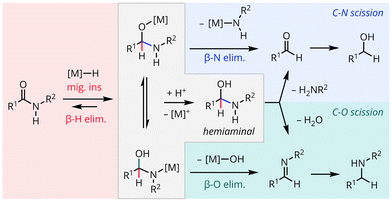 | ||
| Scheme 2 General model for chemoselectivity in amide hydrogenation controlled by relative rates for elimination from metal-bound and hemiaminal intermediates. | ||
Milstein and coworkers have developed a series of PNN pincer ruthenium(II) complexes (such as Ru-1 and Ru-2, where Ru-2 is the superior precatalyst) for hydrogenolysis of amides, including the first report of selective C–N scission (Scheme 3A).36 This reaction is fully reversible, and Ru-1 also catalyses the dehydrogenative coupling of alcohols with amines to form amides with liberation of H2.37,38 Based on established hydrogenation reactivity toward other carbonyl-containing substrates by related catalysts, a mechanism was proposed involving metal–ligand cooperation with aromatization–dearomatization of the heteroaromatic pincer core participating both in (i) heterolytic dihydrogen activation and (ii) substrate organization during metal hydride delivery and hemiaminal breakdown (Scheme 3B).36 Computational studies from Cantillo in 2011 provided support for the feasibility of such a mechanism with Ru-2, albeit with unexpectedly high barriers for both the computed C–O (+52.2 kcal mol−1) and C–N (+51.0 kcal mol−1) scission pathways.39 Several additional computational studies on the microscopic reverse reaction, dehydrogenative coupling of alcohols and amines to generate amides, reached related conclusions on the role of metal–ligand cooperation in a bifunctional, double-hydrogen-transfer mechanism.40–42 However, there was some disagreement on the specific mode of metal–ligand cooperation proposed, with Lei, Liu, Schaefer, and coworkers highlighting potential cooperative involvement of an additional unit of alcohol substrate.43
Since Milstein's initial report, numerous follow-up works have evaluated other metals, pincer ligands, and variations in reaction temperatures and pressures, enabling development of highly efficient catalysts demonstrating thousands of turnovers in only a few hours.44–59 Through kinetic profiling and independent synthesis of catalytically active intermediates in the context of analogous ester hydrogenation reactions, Chianese and coworkers demonstrated that the tertiary amine PNNEt2 ligands utilised in early reports (as in Ru-1) actually undergo hydrodealkylation to generate the corresponding secondary amine PNNEtH ligand (as in Ru-4) before entering the catalytic cycle (Scheme 3C).60,61 Khaskin, Gusev, and coworkers showed that bipyridine-type PNN ligands (as in Ru-2) similarly undergo hydrogenation to afford Noyori-type amido complexes Ru-5 and Ru-6 under typical hydrogenative (and dehydrogenative) reaction conditions (Scheme 3D).62 Accordingly, modifying the PNN pincer arm from a pyridyl or tertiary amine group to a secondary amine (as in Ru-7) enabled ruthenium-catalysed amide hydrogenation at lower temperatures and pressures (rt – 45 °C, 5–10 bar H2vs. 100–150 °C, 10–100 bar H2) (Scheme 3E).63
Deliberate application of these secondary amine PNN complexes under basic conditions revealed formation of an unconventional dearomatized ligand tautomer. In contrast to deprotonation adjacent to the pincer phosphine arm, which had been characterized previously with tertiary amine PNNEt2 complexes, the secondary amine PNNHEt complexes instead formed a doubly deprotonated enamido ligand tautomer (Ru-9, Scheme 3F).63 From this anionic, dearomatized intermediate, proton transfer between secondary amide substrates and the enamido ligand enabled off-cycle formation of an unusual κ1-O coordinated amidate, organized by H-bonding interactions with the ligand (Ru-10).63 When this complex was treated with H2, a dihydride complex (Ru-11) was formed. Upon monitoring by 1H NMR, only amidate complex Ru-10 (not the dihydride) was observed under catalytic conditions with a secondary amide substrates. With tertiary amide substrates, dihydride complex Ru-11 was instead observed as the resting state.63 The persistence of Ru-11 in this case thus suggested that initial reaction of the amide substrate via M–H insertion was the rate-determining step but did not afford any insights into chemoselectivity-determining features.
Follow-up density functional theory (DFT) studies examined the role of secondary amine PNNHR ruthenium complexes in mediating breakdown of the hemiacetal and hemiaminal intermediates formed in ester and amide hydrogenolysis reactions, respectively, with conflicting results.61,64 The lowest barrier pathway identified in the absence of explicit solvent involved H-bonding or proton-transfer from the backbone CH2 to the departing N nucleofuge (Scheme 4A).64 By contrast, inclusion of explicit ethanol solvation enabled identification of a more energetically reasonable pathway involving proton transfer from the PNN secondary amine sidearm to a departing O nucleofuge (Scheme 4B).61 Additional investigation is necessary to assess whether a similar pathway may be operative for hemiaminal breakdown.
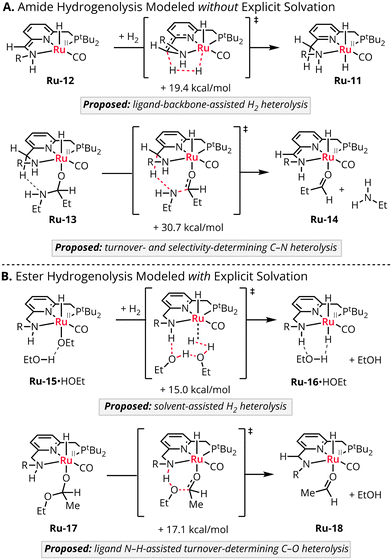 | ||
| Scheme 4 Competing mechanistic proposals from computational studies of secondary amine PNN Ru catalysts for hydrogenolysis of amides and esters. | ||
While additional follow-up studies are clearly needed to resolve the competing mechanistic proposals for hemiaminal breakdown with PNN Ru complexes,65 substantial progress has been made toward the development and understanding of related pincer iron complexes as catalysts for hydrogenation of amides, esters, and CO2.66,67 Contemporaneous reports from the Langer51 and Bernskoetter/Hazari groups53,68 in 2016–2017 described Noyori-type iron complexes such as [(iPrPNHP)Fe(H)2(CO)] (Fe-1, where iPrPNHP = HN(CH2CH2(PiPr2))2) for deaminative hydrogenolysis (C–N scission) of varied formamides with impressive initial rates and turnover numbers (TONs > 1000 in 3 hours at 100 °C, 30 atm H2) (Scheme 5A). Perplexingly, secondary formamide additives were required for most efficient reactivity of tertiary formamides.53
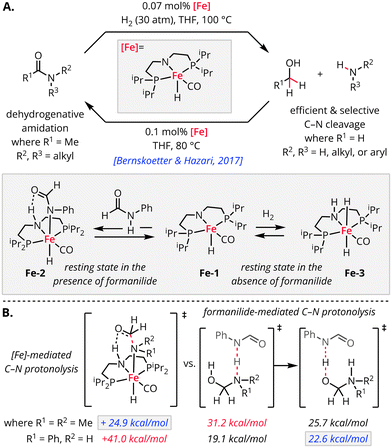 | ||
| Scheme 5 PNP iron catalysed amide hydrogenolysis and substrate-dependent mechanisms for hemiaminal C–N protonolysis in a key chemoselectivity-determining step. | ||
In 2018, Bernskoetter, Hazari, Nova and co-workers disclosed a follow-up study focusing on the mechanism of deaminative hydrogenation and the basis for this unusual additive effect with the iPrPNHP iron system.69 Based on density functional theory (DFT) calculations and microkinetic modelling, they validated the intermediacy of hemiaminals formed from near-thermoneutral insertion into the metal hydride. However, the mechanism for hemiaminal breakdown varied across substrates, where the lowest-barrier pathway for formanilide involved cooperative proton transfer and stabilization of the incipient iron amido during a concerted outer-sphere elimination (Scheme 5B). However, for N,N-dimethylformamide, the corresponding iron-mediated aminolysis step was instead kinetically prohibitive as a stepwise process. Based on this observation, the authors invoked a co-catalytic role for the secondary formamide additive in assisting with the final elimination step without the involvement of iron (Scheme 5B). This finding was particularly significant because it challenged the conventional assumption that hydrogenation reactivity toward electron-rich carboxylic acid-derivatives was limited exclusively by the metal-hydride hydricity. Furthermore, this mechanistic insight was extended to the rational development of an optimized guanidine co-catalyst (triazabicyclodecene, TBD) that maximized rates of proton transfer while minimizing catalyst poisoning and other decomposition processes.70,71
Although the examples of amide hydrogenation catalysts discussed above all involve pincer metal complexes, substantial opportunity for innovation beyond this catalyst space remains. As a highlight, in 2022, Razayee and coworkers disclosed a distinct, 1,10-phenanthroline-2,9-diol-supported iridium catalyst system (Ir-1) capable of achieving switchable C–O and C–N scission of carboxamides (Scheme 6).72 Under acidic conditions, exclusive C–O scission was observed. However, when a base was introduced into the hydrogenation process, chemoselectivity switched to favour C–N scission instead. The proximity of the ligand protic site near the metal further proved crucial for this C–N activation. The researchers hypothesized that these catalysts may rely on a distinct mode of metal–ligand-cooperativity for H2 heterolysis and/or substrate activation. As such, additional mechanistic work is needed to distinguish the potentially generalizable, chemoselectivity-determining features defined by this distinct catalyst system.
4. 2e− redox-cycling mechanisms
Perhaps the most widely appreciated motivation for pursuing transition metal catalysis is the opportunity to achieve transformations with no direct organic counterparts through multi-electron redox changes. As such, it is logical that 2e− redox-cycling mechanisms, especially Ni(0/II) and Pd(0/II) catalytic cycles, are most commonly invoked for non-hydrogenative C(acyl)–N functionalisation. The typical proposed mechanism for a M(0/II) cycle begins with oxidative addition of the electrophile into the M(0) catalyst (step i), resulting in the formation of an acyl metal intermediate (Scheme 7). This intermediate undergoes transmetallation (step ii) with a nucleophile, and subsequent reductive elimination (step iii) yields the carbonyl-retentive product. Alternatively, CO deinsertion (step ii′) prior to reductive elimination (step v′) would afford the decarbonylated product. Slight variations involving transmetallation prior to oxidative addition are also possible.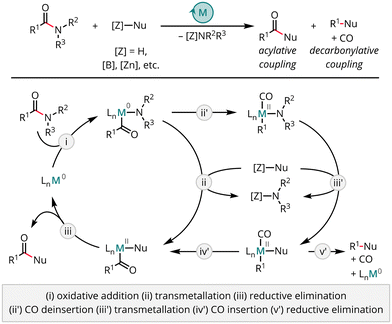 | ||
| Scheme 7 General 2e− redox-cycling mechanism proposed for acylative and decarbonylative coupling reactions with C(acyl)–N electrophiles. Nu = nucleophile. | ||
In 2015, the Szostak and Zou groups independently reported the first examples of palladium-catalysed cross-coupling reactions between twisted amides and boronic acids to yield carbonyl-retentive ketone products (Scheme 8A and B).73,74 Both reports included mechanistic proposals involving Pd(0)-mediated oxidative addition into the substrate C(acyl)–N bond, where substrate conversion (and product yield) correlated with the degree of ground-state C(O)–N distortion. Additionally, Szostak and coworkers detected mono- and bis-phosphine-supported palladium acyl and aryl species through electrospray ionization mass spectrometry (ESI/MS) analysis.74 These findings provided supporting evidence that amide C(acyl)–N bond activation followed an oxidative addition pathway in this case.
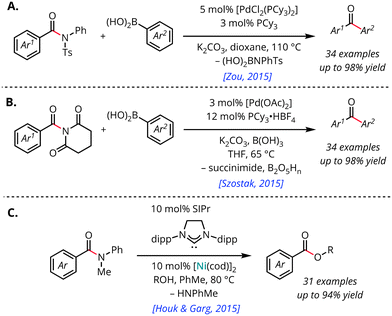 | ||
| Scheme 8 Key early developments in Pd- and Ni-catalysed acylative coupling using C(acyl)–N electrophiles. Ar = aryl; cod = 1,5-cycloctadiene; dipp = 2,6-diisopropylphenyl; Ts = 4-toluenesulfonyl. | ||
In the same year, the Garg group reported the first Ni-catalysed C(acyl)–N functionalisation of amides.75 Utilizing the electron-rich SIPr/Ni system (SIPr = 1,3-bis(2,6-di-isopropylphenyl)imidazolidin-2-ylidene), Garg and coworkers successfully carried out esterification of weakly activated N-methyl-benzanilide (Scheme 8C). Based on evaluation of the reaction coordinate diagram using DFT, they also proposed oxidative addition to be the rate-determining step in the reaction.75 A follow-up kinetic modelling study examined the esterification of N-methyl-benzanilide with (−)-menthol and found that the kinetic data could be fitted to a series of steps agreeing with this computational model. This study also identified a competitive unknown pathway for catalyst degradation.76
Following these pivotal early demonstrations, there have been numerous reports of Ni77–104 and Pd73,95,105–114 and (to a lesser extent) other metal-catalysed115–119 methods for acylative and decarbonylative functionalisation of amides.2,109,120 However, despite these synthetic developments, mechanistic studies, especially experimental mechanistic studies, have been comparatively limited.
4.1 Experimental mechanistic studies with Ni
The first report providing experimental evidence for the accessibility of Ni(II) species by C(acyl)–N bond activation in amides was reported by Shi and coworkers in 2016.93 They reported a decarbonylative borylation of amides using Ni(OAc)2·2H2O and ICy·HCl (ICy = 1,3-dicyclohexylimidazolidene) to generate the active catalyst in situ.93 Through stoichiometric studies using [Ni(cod)2] in place of Ni(OAc)2·2H2O, they successfully isolated a bis(NHC)-supported Ni(II) acyl species (Ni-1), which underwent decarbonylation to form the corresponding Ni(II) aryl (Ni-2) upon heating (Scheme 9A). Subsequent treatment of Ni-2 with B2nep2 (nep = neopentyl glycolato) resulted in the formation of the desired borylated product, thereby confirming the decarbonylated species as an intermediate in the reaction. Both Ni-1 and Ni-2 were fully characterized by SC-XRD, and Ni-1 proved to be an effective catalyst for the net borylation, further supporting the catalytic relevance of the isolated species.Soon thereafter in 2017, Lahiri, Maiti, and coworkers reported detection by ESI-MS of cod-supported Ni(II) acyl species (Ni-3 and Ni-4) in the context of a phosphine/Ni-catalysed deamidative reduction of N-acyl pyrazoles (Scheme 9B).121 The authors also validated the formation of Ni(CO)n(EtPPh2)2 (Ni-6) by IR spectroscopy and SC-XRD and demonstrated that the Ni(CO)n(EtPPh2)2 adducts were chemically competent for the reductive transformation at high temperatures (130 °C).
In 2023, both the Kennedy122 and Morandi123 labs independently reported further mechanistic organometallic work using single-component [Ni(SIPr)(benzene)] (Ni-7) and [Ni(IPr)(toluene)] (Ni-11) precatalysts, respectively. Kennedy and coworkers evaluated both the accessibility and catalytic activity of Ni(0), Ni(I) nucleophile (Ni-8), and Ni(II) acyl (Ni-9 and Ni-10) complexes (Scheme 10A).122 They demonstrated that carbamate activating groups played key roles in both the kinetic accessibility and thermodynamics of C(acyl)–N oxidative addition at Ni(0), where the carbamate acts as a chelating ligand to stabilize the Ni(II) acyl (Ni-9 or Ni-10) and inhibit CO-deinsertion. Based on a double-labelling crossover experiment, Kennedy and coworkers also provided the first experimental evidence for the kinetic accessibility of C(acyl)–N oxidative addition with relatively unactivated amides such as N-methyl-benzanilide, where the corresponding Ni(II) acyl lies energetically uphill (Keq < 1, Scheme 10B). Finally, they demonstrated that Ni(I) species are formed under catalytically relevant conditions through comporoportionation of Ni-7 and Ni-9. This process represented a primary catalyst deactivation pathway where the Ni(I) adducts afforded reduced or no catalytic activity (depending on the amide) and counterproductive chemoselectivity favouring cleavage of carbamoyl activating groups. As such, this work provided molecular-level insight into the catalyst deactivation processes noted previously and suggested that single-component precatalysts avoiding inefficient in situ activation could enable the use of lower catalyst loadings that would circumvent this challenge.
Morandi and coworkers demonstrated analogous C(acyl)–N oxidative addition with carbamate-activated aliphatic lactams.123 As noted by the Kennedy team, Morandi and coworkers found that the carbamate acted as a chelating group to stabilize the resulting Ni(II) acyl metallacycles (Ni-12 and N-14). However, they found that metallacycle ring-size and -strain, presumably controlling the geometry of carbamate chelation, gated the accessibility of decarbonylation (Scheme 10C). With 7-membered (from δ-lactams) and larger acyl nickelacycles (such as Ni-14), CO deinsertion and dissociation proceeded readily at room temperature. By contrast, CO deinsertion and dissociation from 6-membered acyl nickelacycles (such as Ni-12, from γ-lactams) proceeded slowly over multiple days and not at all from the corresponding 5-membered acyl nickelacycles (from β-lactams).
In complementary work, Stanley and coworkers reported the Ni-catalysed intramolecular carboacylation of alkenes via C(acyl)–N activation of amides (Scheme 11A).88 Shortly thereafter, the same group reported a 3-component variant using norbornenes as the alkene component.89 These reactions constitute examples of conjunctive (rather than direct) cross-coupling with C(acyl)–N electrophiles.124 In both cases, the authors performed several competition experiments to evaluate the nature of the product-determining steps and the plausible sequences of migratory insertion and transmetallation. Competition experiments between electron-rich and electron-deficient amides yielded a preference for product formation from the electron-deficient amide (Scheme 11B). Electron-rich species have been shown to favour oxidative addition by decreasing C![[double bond, length as m-dash]](https://www.rsc.org/images/entities/char_e001.gif) N character;18 however, the arene electronics should have no impact on the rate of distal C–C reductive elimination. Taken together, this result led the authors to conclude that neither oxidative addition nor reductive elimination was rate- or product-determining. Interestingly, in the case of intramolecular carboacylation, they observed that ketones derived from electron-deficient and sterically hindered aryl boron nucleophiles exhibited higher yields than their more nucleophilic electron-rich, unhindered counterparts (Scheme 11C).88 This observation suggested that transmetallation also was not rate-determining. However, the use of even stronger Ph2Zn nucleophiles led to the formation of direct acylative Suzuki–Miyara coupling products,89 suggesting that transmetallation must follow (rather than precede) migratory insertion. By process of elimination, the author's concluded that migratory insertion was most likely the rate-determining step for intramolecular carboacylation.88 However the observations may also be consistent with rate- and product-determining reductive elimination, as was concluded for the 3-component carboacylation.89
N character;18 however, the arene electronics should have no impact on the rate of distal C–C reductive elimination. Taken together, this result led the authors to conclude that neither oxidative addition nor reductive elimination was rate- or product-determining. Interestingly, in the case of intramolecular carboacylation, they observed that ketones derived from electron-deficient and sterically hindered aryl boron nucleophiles exhibited higher yields than their more nucleophilic electron-rich, unhindered counterparts (Scheme 11C).88 This observation suggested that transmetallation also was not rate-determining. However, the use of even stronger Ph2Zn nucleophiles led to the formation of direct acylative Suzuki–Miyara coupling products,89 suggesting that transmetallation must follow (rather than precede) migratory insertion. By process of elimination, the author's concluded that migratory insertion was most likely the rate-determining step for intramolecular carboacylation.88 However the observations may also be consistent with rate- and product-determining reductive elimination, as was concluded for the 3-component carboacylation.89
4.2 Computational mechanistic studies with Ni
Beginning from the earliest reports of metal-catalysed cross-coupling with twisted-amide electrophiles, computational studies have played a key role in rationalizing general reactivity and chemoselectivity trends.125 Building from Houk and coworkers’ initial examination of Ni-catalysed esterification of amides,75 a series of papers from the Zhao,126 Fu,127 and Hong128 groups in 2016 and 2017 addressed Ni-catalysed Suzuki–Miyaura couplings using N-benzoyl carbamates126,127 and glutarimindes128 as electrophiles, respectively. Generally, these studies only addressed the feasibility of 2e− redox-cycling mechanisms, although redox-neutral mechanistic proposals may also be viable in some cases.Zhu, Zhao, and coworkers revealed that the chemoselectivity of oxidative addition into N-benzyl-N-tert-butoxycarbonyl (N-Bn-N-Boc) benzamide is under thermodynamic control with the SIPr/Ni catalyst system (Scheme 12A).126 Although oxidative addition of Ni(0) into the C(acyl)–N and C(carbamoyl)–N bonds share similar activation barriers, the product of C(acyl)–N oxidative addition is nearly 10 kcal mol−1 more stable, due in part to the favourable chelating ability of the carbamate leaving group.
Hong and coworkers examined the complementary PCy3/Ni catalyst system, which promoted decarbonylative Suzuki–Miyaura coupling using N-acyl glutarimide electrophiles.128 In contrast to the studies examining the SIPr/Ni catalyst system, they found that chelation of the glutarimide O to Ni substantially lowered the barrier for oxidative addition in addition to stabilizing the resulting Ni(II) acyl complex (Scheme 12B). They noted a similar, albeit higher energy, pathway with the analogous benzoyl carbamates as well. Additionally, they examined the origin of chemoselectivity for decarbonylated vs. carbonyl-retentive products. As in prior studies, they noted that the barrier for carbonyl-retentive reductive elimination was lower than that of CO deinsertion, rendering the carbonyl-retentive ketone the kinetically preferred product for reactions with strong nucleophiles at moderate temperatures. However, for reactions requiring higher temperatures to achieve transmetallation, the ketone could be activated to allow access to the thermodynamically-favoured decarbonylative product. Their computational findings were validated by a contemporaneous report from Tobisu, Chatani, and coworkers on the nickel-mediated decarbonylation of unstrained ketones.129
In 2018, the Dang group reported a theoretical study comparing the esterification of α-aryl and α-alkyl amides,130 which required different ligand designs in their development.75,79 Dang and coworkers suggested that a 2e− redox-cycling pathway was likely conserved across the different amide and ligand combinations, and rationalized the basis for substrate–ligand matching effects. With α-aryl amides, they proposed that the electron-richness of the SIPr vs. terpyridine ligands was responsible for gating the energetic accessibility of the oxidative addition step. Conversely, they noted that the SIPr ligand system resulted in a prohibitively high barrier for proton-transfer between MeOH and NBnBoc during the ligand metathesis step with α-alkyl amides. Building upon these findings, they also computationally proposed that an electron-rich terpyridine ligand bearing multiple dimethylamine groups could carry out esterification of both aryl and alkyl amides. To the best of our knowledge, this prediction has not been tested experimentally.
In summarizing these works, Hong and coworkers noted that, across systems, Ni(0) can interact with acyl and amine fragments through two distinct mechanistic pathways for oxidative addition (Scheme 12C).125,131 The type A mechanism resembles classical oxidative addition mechanisms through a 3-centered transition state leading to cleavage of the C(acyl)–N bond. In the type B pathway, a coordinating substituent on N can induce chelation-assisted oxidative addition through a larger-membered transition state. In most cases, the stability obtained through chelation does not sufficiently compensate for the energy penalty due to distortion from the 3-membered transition state. As a result, the type A mechanisms are generally preferred, even for substrates bearing a chelating group. As such, the chelation of carbamate activating groups noted by Kennedy122 and Morandi123 reflects primarily product- rather than transition-state stabilization. By contrast, substrates that are highly twisted from planarity in their ground states (such as N-acyl glutarimides) avoid this energetic penalty when proceeding through the type B, chelate-assisted oxidative addition. Regardless of mechanistic manifold, the primary factor responsible for the cleavage of the C(acyl)–N bond is the π coordination of Ni to the acyl fragment, which further weakens nN → π*CO delocalisation, and the barrier for oxidative addition can be correlated with the heterolytic bond strength (pKa) of the corresponding leaving group.
4.3 Mechanistic studies with other metals
Though much of the reported work involves palladium and nickel, there have also been reports on amide C–N activation using several other metals as catalysts. However, the mechanistic studies using these metals have been limited. The first rhodium-catalysed acyl C–N bond activation was reported by the Szostak group in 2016 using the [Rh(cod)Cl]2 system (Scheme 13A).115 This work featured directed C–H arylation of pyridyl arenes using N-acyl glutarimides as the electrophilic coupling partners. Using ESI-MS analysis of reactions conducted with stoichiometric mixtures of [Rh], base, and amide, the authors detected formation of rhodium aryl intermediates (such as Rh-1), consistent with oxidative addition of the C–N bond of the amide to the Rh(I) catalyst, accompanied by elimination of CO.The first cobalt-catalysed amide C–N bond activation was reported by Gosmini, Danoun, and coworkers in 2017, wherein CoBr2 in combination with bipyridine and TMSCl-activated manganese catalysed the esterification N-Boc with primary and secondary alcohols.118 Even though a deep mechanistic understanding of this reaction has yet to be revealed, they proposed a possible mechanism that proceeds via the oxidative addition of the acyl C–N bond of the amide substrate into a Co(0) catalyst generated in situ.
In 2021, Zhang, Bao, and coworkers reported the first ruthenium catalyst for the C(acyl)–N bond activation of amides (Scheme 13B).119 Using [RuCl2(p-cymene)2] as a precatalyst in combination with K2CO3 and 2,4,6-triisopropylbenzoic acid additives, they developed methodology for C–H acylation of 2-arylpyridines using N-phenyl-N-tosylamides as acylating agents. Based on the absence of an H-atom kinetic isotope effect in competition experiments, they concluded that C–H activation was unlikely to be rate-determining. Cycloruthenated complex Ru-19 was found to be an effective catalyst, but only in the presence of additional 2-arylpyridine. Based on this observation, the authors proposed that a bis-cycloruthenated complex Ru-20 was responsible for C(acyl)–N activation in the rate-determining step (Scheme 13C).
4.4 Outstanding mechanistic questions
Taken together, these works hint at the versatile potential of C(acyl)–N functionalisation through 2e− redox-cycling mechanisms but also highlight the many frontiers still to be evaluated. While the mechanistic work from the Szostak, Shi, Maiti, Kennedy, and Morandi labs provided unambiguous evidence for the feasibility of C(acyl)–N oxidative addition at neutral Pd(0)74 and Ni(0),93,122,123 the nature of oxidative addition with other metals has been evaluated less extensively. Additionally, even in the context of nickel catalysis, all of the mechanistic studies performed to-date have examined reactions with relatively weak nucleophiles or reactions proceeding in the absence of an exogenous nucleophile altogether. Alternative pathways involving nickelate formation must be considered further, especially in cases involving stronger nucleophiles such as organozinc, organoaluminum, or organomagnesium reagents.132–134 The resulting metalates may then react either through redox-neutral insertion/elimination-type or 2e− redox-cycling mechanistic manifolds.Additionally, for reactions involving conjunctive cross-couplings or apparent Heck-type reactions across a π system, the possibility of competing oxidative cyclization manifolds must be considered (Scheme 14).135,136 Computational studies from Sato and coworkers on a related transformation indicated that oxidative cyclization manifolds were substantially lower in energy than alternatives proceeding through C(acyl)–O oxidative addition.137 Oxidative cyclization-type mechanisms are also prevalent for [Ni]/NHC-catalysed transformations involving aldehydes138,139 and α,β-unsaturated esters.140–142 The intriguing possibilities of tapping alternative mechanisms, with distinct chemoselectivity profiles depending on the specific combinations of reagents merit further study and hold promise for future synthetic innovation.
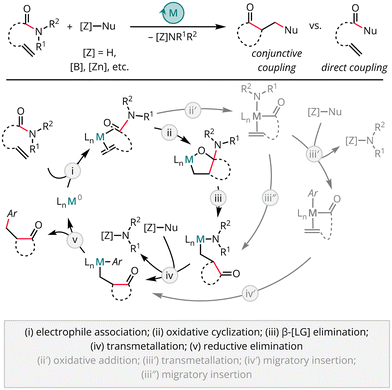 | ||
| Scheme 14 Alternative mechanistic proposal for conjunctive coupling reactions with C(acyl)–N electrophiles. | ||
5. 1e− mechanisms
Building on the developments of C(acyl)–N functionalisation by 2e− redox-cycling mechanisms, more complex catalytic mechanisms involving both 2e− and 1e− steps were soon investigated. This work was supported by the surge of interest in reductive cross coupling, metallaphotoredox catalysis, and electrocatalytic organic synthesis. Initial works in this area relied on the Ni(0)-enabled oxidative addition reactivity discussed above,143,144 but more recently, the potential 1e− reactivity of activated amides has been recognized to provide access to an expanding range of transformations.145–147In 2017, the Molander group reported a dual photoredox and nickel-catalysed acylation of potassium alkyl fluoroborates with N-acyl succinimide electrophiles to form aliphatic ketones (Scheme 15A).143 Although their report did not include any mechanistic experiments, the authors drew on related prior works to propose two plausible mechanistic paths beginning from Ni(0), with simultaneous photoredox-catalyst-enabled oxidative fragmentation of the alkyltrifluoroborate (Scheme 15B, steps i–ii). Sequential C(acyl)–N oxidative addition and alkyl radical capture, in either order, would lead to a common Ni(III) acyl intermediate (steps iv–v or iv′–v′). Reductive elimination (step vi) would form the product and a Ni(I) complex, which was proposed to undergo SET with Ir(II) to regenerate the active Ni(0) species and ground state Ir(III) photocatalyst (step iii).
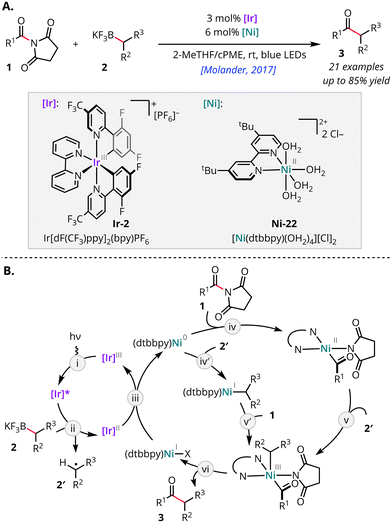 | ||
| Scheme 15 Key early development in Ni-catalysed acylative coupling using a C(acyl)–N electrophile with dual photoredox and Ni catalysis. | ||
The same year, Han and coworkers reported a method for reductive cross-coupling of N-acyl glutarimides with aryl iodides (Scheme 16A).144 Based on radical trapping experiments and the observation of Ni acyl species by ESI-MS, the authors proposed a catalytic cycle in which the tpy/Ni(0) (tpy = 2,2′;6′,2′′-terpyridine) catalyst selectively undergoes C(acyl)–N oxidative addition (Scheme 16B, step ii) prior to capture of an aryl radical generated through a chain mechanism (step iii). Reductive elimination from the resulting Ni(III) acyl complex (step iv) would form the observed ketone product. Halide abstraction by the resulting Ni(I) would generate additional phenyl radical (step v), and subsequent reduction with Zn(0) (step vi) would regenerate the active Ni(0) species.
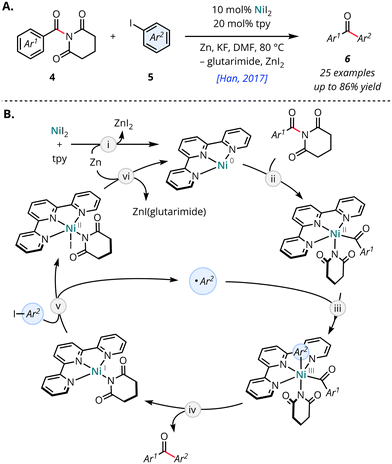 | ||
| Scheme 16 Key early development in Ni-catalysed reductive acylative cross-coupling using a C(acyl)–N electrophile. | ||
In 2020 and 2021, the Baik & Hong groups and the Amgoune group independently reported highly similar methods involving dual photoredox and Ni-catalysed acylation of alkanes with N-acyl succinimide electrophiles (Scheme 17A).145,146 Both groups used Ni(II) salts in combination with dtbbpy (dtbbpy = 4,4′-di-tert-butyl-2,2′-dipyridyl) as precatalysts under the assumption that reduced nickel species would be generated in situ under the photoredox conditions. Amgoune and coworkers demonstrated through the combination of NMR monitoring and SC-XRD analysis that Ni(II)-acyl and Ni(II)-aryl (Ni-26) species formed readily upon treatment of N-benzoylsuccinimide with [(dtbbpy)Ni(cod)] (Ni-25).146 However, quite surprisingly, Ni-25 performed very poorly as a catalyst (yielding only 8% of the desired product), and the isolated Ni(II)-aryl (Ni-26) was completely inactive (Scheme 17B). Moreover, more active acyl electrophiles such as benzoyl chloride and benzoic anhydride were poor substrates in comparison with N-benzoylsuccinimide.145 These observations suggested that, despite its accessibility, the Ni(0/II) oxidative addition pathway was likely not operative in the overall catalytic transformation. By contrast, Amgoune and coworkers found that a Ni(I) dimer (Ni-27) was catalytically active for the reaction and even showed higher efficiency than their original Ni(II) catalyst (Scheme 17B).146 Baik, Hong, and coworkers supplemented these surprising experimental findings with a detailed computational investigation, which suggested that C–H activation via a photoinduced reaction from [(dtbbpy)NiCl3], preceded C(acyl)–N oxidative addition. Following multiple reductions mediated by the photocatalyst, a Ni(I) alkyl complex (Ni-23) was proposed to be responsible for the C(acyl)–N oxidative addition to form Ni-24, which undergoes facile reductive elimination to form the ketone product.
In a subsequent report, the Amougne and Vantourout groups built on these findings to develop an electro-reductive coupling of N-acyl succinimides with alkyl halides using an analogous dtbbpy/nickel catalyst system (Scheme 18A).147 Through a series of cyclic voltammetry (CV) studies, the authors demonstrated that an electrogenerated Ni(I) species (Ni-29) can activate both the alkyl bromide (by SET and alkyl radical formation, Scheme 18B, step ii) and the N-acyl imide (by C–N oxidative addition, step iii) electrophiles. The authors proposed that rapid comproportionation of the resulting Ni(III) acyl with remaining Ni-29 or electroreduction would afford the corresponding Ni(II) acyl (step iv), which could then capture the alkyl radical en route to the cross-coupled product (Scheme 18B, steps v–vi).
Taken together, these works challenge key assumptions about catalytically relevant mechanisms of N-acyl-imide activation and highlight the importance of evaluating mechanistic assumptions experimentally. They further suggest that a broader range of mechanisms than previously assumed may be operative for many of the C(acyl)–N functionalisation reactions developed to date, highlighting opportunities for further innovation within these diverse mechanistic manifolds.
6. Outlook & conclusions
In conclusion, substantial recent work has provided foundational insights into several distinct mechanisms through C(acyl)–N functionalisation through redox-neutral, 2e− redox-cycling, and 1e− mechanisms. These studies hold promise for informing the development of new catalytic methodologies that overcome current limitations to catalytic efficiency and enable entirely new reactivity patterns. However, these studies have only scratched the surface, and many questions remain to be evaluated. The field is ripe for continued synergy of mechanistic study and reaction discovery to push the boundaries of C(acyl)–N functionalisation catalysis.Author contributions
VGP – conceptualization, investigation, writing – original draft, writing – review & editing, visualization. KRM – investigation, writing – review & editing. CRK – conceptualization, writing – original draft, writing – review & editing, visualization, supervision, project administration, funding acquisition.Data availability
No primary research results, software or code have been included and no new data were generated or analysed as part of this review.Conflicts of interest
There are no conflicts to declare.Acknowledgements
Research reported in this publication was supported through start-up funding from the University of Rochester and by the National Institute of General Medical Sciences of the National Institutes of Health under Award Number R35GM150833. The content is solely the responsibility of the authors and does not necessarily represent the official views of the National Institutes of Health. V. G. P. acknowledges the University of Rochester Department of Chemistry for Sherman–Clarke and Weissberger Memorial Fellowships.References
- J. I. Mujika, J. M. Matxain, L. A. Eriksson and X. Lopez, Chem. – Eur. J., 2006, 12, 7215–7224 CrossRef CAS PubMed.
- G. Li, S. Ma and M. Szostak, Trends Chem., 2020, 2, 914–928 CrossRef CAS.
- C. Liu and M. Szostak, Chem. – Eur. J., 2017, 23, 7157–7173 CrossRef CAS PubMed.
- J. E. Dander and N. K. Garg, ACS Catal., 2017, 7, 1413–1423 CrossRef CAS PubMed.
- T. B. Boit, A. S. Bulger, J. E. Dander and N. K. Garg, ACS Catal., 2020, 10, 12109–12126 CrossRef CAS PubMed.
- Amide Bond Activation: Concepts and Reactions, ed. M. Szostak, Wiley, 2022 Search PubMed.
- Q. Wang, Y. Su, L. Li and H. Huang, Chem. Soc. Rev., 2016, 45, 1257–1272 RSC.
- K. Ouyang, W. Hao, W.-X. Zhang and Z. Xi, Chem. Rev., 2015, 115, 12045–12090 CrossRef CAS PubMed.
- E. V. Anslyn and D. A. Dougherty, in Modern Physical Organic Chemistry, University Science Books, 2006, ch. 600–607 Search PubMed.
- P. Gao, M. M. Rahman, A. Zamalloa, J. Feliciano and M. Szostak, J. Org. Chem., 2022, 88(19), 13371–13391 CrossRef PubMed.
- M. Szostak and J. Aube, Chem. Rev., 2013, 113, 5701–5765 CrossRef CAS PubMed.
- G. Meng, J. Zhang and M. Szostak, Chem. Rev., 2021, 121, 12746–12783 CrossRef CAS PubMed.
- R. Szostak, S. Shi, G. Meng, R. Lalancette and M. Szostak, J. Org. Chem., 2016, 81, 8091–8094 CrossRef CAS PubMed.
- L. Ielo, V. Pace, W. Holzer, M. M. Rahman, G. Meng, R. Szostak and M. Szostak, Chem. – Eur. J., 2020, 26, 16246–16250 CrossRef CAS PubMed.
- R. Szostak, J. Aube and M. Szostak, Chem. Commun., 2015, 51, 6395–6398 RSC.
- V. Pace, W. Holzer, L. Ielo, S. Shi, G. Meng, M. Hanna, R. Szostak and M. Szostak, Chem. Commun., 2019, 55, 4423–4426 RSC.
- P. Lei, G. Meng, S. Shi, Y. Ling, J. An, R. Szostak and M. Szostak, Chem. Sci., 2017, 8, 6525–6530 RSC.
- R. Szostak, G. Meng and M. Szostak, J. Org. Chem., 2017, 82, 6373–6378 CrossRef CAS PubMed.
- J. M. Buccigross and S. A. Glover, J. Chem. Soc., Perkin Trans. 2, 1995, 595–603, 10.1039/P29950000595.
- S. A. Glover, Tetrahedron, 1998, 54, 7229–7271 CrossRef CAS.
- S. A. Glover, G. Mo and A. Rauk, Tetrahedron, 1999, 55, 3413–3426 CrossRef CAS.
- S. A. Glover and A. Rauk, J. Chem. Soc., Perkin Trans. 2, 2002, 1740–1746, 10.1039/B204232K.
- S. A. Glover, J. M. White, A. A. Rosser and K. M. Digianantonio, J. Org. Chem., 2011, 76, 9757–9763 CrossRef CAS PubMed.
- S. A. Glover and A. A. Rosser, Molecules, 2018, 23(11), 2834 CrossRef.
- S. H. Kennedy, B. D. Dherange, K. J. Berger and M. D. Levin, Nature, 2021, 593, 223–227 CrossRef CAS.
- C. Zippel, J. Seibert and S. Bräse, Angew. Chem., Int. Ed., 2021, 60, 19522–19524 CrossRef CAS PubMed.
- K. J. Berger, J. L. Driscoll, M. Yuan, B. D. Dherange, O. Gutierrez and M. D. Levin, J. Am. Chem. Soc., 2021, 143, 17366–17373 CrossRef CAS PubMed.
- B. D. Dherange, M. Yuan, C. B. Kelly, C. A. Reiher, C. Grosanu, K. J. Berger, O. Gutierrez and M. D. Levin, J. Am. Chem. Soc., 2023, 145, 17–24 CrossRef CAS.
- C. Lv, R. Zhao, X. Wang, D. Liu, T. Muschin, Z. Sun, C. Bai, A. Bao and Y. S. Bao, J. Org. Chem., 2023, 88, 2140–2157 CrossRef CAS.
- A. M. Smith and R. Whyman, Chem. Rev., 2014, 114, 5477–5510 CrossRef CAS PubMed.
- J. Pritchard, G. A. Filonenko, R. van Putten, E. J. M. Hensen and E. A. Pidko, Chem. Soc. Rev., 2015, 44, 3808–3833 RSC.
- H. Zhao, A. Ariafard and Z. Lin, Organometallics, 2006, 25, 812–819 CrossRef CAS.
- V. T. Tran, J. A. Gurak, K. S. Yang and K. M. Engle, Nat. Chem., 2018, 10, 1126–1133 CrossRef CAS PubMed.
- M. Karimzadeh-Younjali and O. F. Wendt, Helv. Chim. Acta, 2021, 104, e2100114 CrossRef CAS.
- M. K. Bogdos, O. Stepanović, A. Bismuto, M. G. Luraschi and B. Morandi, Nat. Synth., 2022, 1, 787–793 CrossRef.
- E. Balaraman, B. Gnanaprakasam, L. J. W. Shimon and D. Milstein, J. Am. Chem. Soc., 2010, 132, 16756–16758 CrossRef CAS PubMed.
- C. Gunanathan, Y. Ben-David and D. Milstein, Science, 2007, 317, 790–792 CrossRef CAS PubMed.
- D. Milstein, Top. Catal., 2010, 53, 915–923 CrossRef CAS.
- D. Cantillo, Eur. J. Inorg. Chem., 2011, 2011, 3008–3013 CrossRef CAS.
- H. Li, X. Wang, F. Huang, G. Lu, J. Jiang and Z.-X. Wang, Organometallics, 2011, 30, 5233–5247 CrossRef CAS.
- G. Zeng and S. Li, Inorg. Chem., 2011, 50, 10572–10580 CrossRef CAS PubMed.
- D. Cho, K. C. Ko and J. Y. Lee, Organometallics, 2013, 32, 4571–4576 CrossRef CAS.
- L. Li, M. Lei, L. Liu, Y. Xie and H. F. Schaefer III, Inorg. Chem., 2018, 57, 8778–8787 CrossRef CAS PubMed.
- J. M. John and S. H. Bergens, Angew. Chem., Int. Ed., 2011, 50, 10377–10380 CrossRef CAS PubMed.
- J. M. John, R. Loorthuraja, E. Antoniuk and S. H. Bergens, Catal. Sci. Technol., 2015, 5, 1181–1186 RSC.
- M. Ito, T. Ootsuka, R. Watari, A. Shiibashi, A. Himizu and T. Ikariya, J. Am. Chem. Soc., 2011, 133, 4240–4242 CrossRef CAS PubMed.
- T. Miura, I. E. Held, S. Oishi, M. Naruto and S. Saito, Tetrahedron Lett., 2013, 54, 2674–2678 CrossRef CAS.
- N. M. Rezayee, C. A. Huff and M. S. Sanford, J. Am. Chem. Soc., 2015, 137, 1028–1031 CrossRef CAS PubMed.
- J. R. Cabrero-Antonino, E. Alberico, H.-J. Drexler, W. Baumann, K. Junge, H. Junge and M. Beller, ACS Catal., 2016, 6, 47–54 CrossRef CAS.
- J. A. Garg, S. Chakraborty, Y. Ben-David and D. Milstein, Chem. Commun., 2016, 52, 5285–5288 RSC.
- F. Schneck, M. Assmann, M. Balmer, K. Harms and R. Langer, Organometallics, 2016, 35, 1931–1943 CrossRef CAS.
- L. Shi, X. Tan, J. Long, X. Xiong, S. Yang, P. Xue, H. Lv and X. Zhang, Chem. – Eur. J., 2017, 23, 546–548 CrossRef CAS PubMed.
- U. Jayarathne, Y. Zhang, N. Hazari and W. H. Bernskoetter, Organometallics, 2017, 36, 409–416 CrossRef CAS.
- V. Papa, J. R. Cabrero-Antonino, E. Alberico, A. Spanneberg, K. Junge, H. Junge and M. Beller, Chem. Sci., 2017, 8, 3576–3585 RSC.
- T. Miura, M. Naruto, K. Toda, T. Shimomura and S. Saito, Sci. Rep., 2017, 7, 1586 CrossRef PubMed.
- T. Leischner, L. Artús Suarez, A. Spannenberg, K. Junge, A. Nova and M. Beller, Chem. Sci., 2019, 10, 10566–10576 RSC.
- S. Kar, A. Goeppert, J. Kothandaraman and G. K. S. Prakash, ACS Catal., 2017, 7, 6347–6351 CrossRef CAS.
- S. Kar, R. Sen, J. Kothandaraman, A. Goeppert, R. Chowdhury, S. B. Munoz, R. Haiges and G. K. S. Prakash, J. Am. Chem. Soc., 2019, 141, 3160–3170 CrossRef CAS PubMed.
- S. Kar, A. Goeppert and G. K. S. Prakash, J. Am. Chem. Soc., 2019, 141, 12518–12521 CrossRef CAS PubMed.
- T. He, J. C. Buttner, E. F. Reynolds, J. Pham, J. C. Malek, J. M. Keith and A. R. Chianese, J. Am. Chem. Soc., 2019, 141, 17404–17413 CrossRef CAS PubMed.
- J. Pham, C. E. Jarczyk, E. F. Reynolds, S. E. Kelly, T. Kim, T. He, J. M. Keith and A. R. Chianese, Chem. Sci., 2021, 12, 8477–8492 RSC.
- L. N. Dawe, M. Karimzadeh-Younjali, Z. Dai, E. Khaskin and D. G. Gusev, J. Am. Chem. Soc., 2020, 142, 19510–19522 CrossRef CAS PubMed.
- S. Kar, M. Rauch, A. Kumar, G. Leitus, Y. Ben-David and D. Milstein, ACS Catal., 2020, 10, 5511–5515 CrossRef CAS PubMed.
- A. Kumar, N. von Wolff, M. Rauch, Y. Q. Zou, G. Shmul, Y. Ben-David, G. Leitus, L. Avram and D. Milstein, J. Am. Chem. Soc., 2020, 142, 14267–14275 CrossRef CAS PubMed.
- H. Li and M. B. Hall, ACS Catal., 2015, 5, 1895–1913 CrossRef CAS.
- W. H. Bernskoetter and N. Hazari, in Pincer Compounds, ed. D. Morales-Morales, Elsevier, 2018, ch. 6, pp. 111–131. DOI:10.1016/B978-0-12-812931-9.00006-2.
- D. S. Mérel, M. L. T. Do, S. Gaillard, P. Dupau and J.-L. Renaud, Coord. Chem. Rev., 2015, 288, 50–68 CrossRef.
- E. M. Lane, K. B. Uttley, N. Hazari and W. Bernskoetter, Organometallics, 2017, 36, 2020–2025 CrossRef CAS.
- L. Artús Suàrez, Z. Culakova, D. Balcells, W. H. Bernskoetter, O. Eisenstein, K. I. Goldberg, N. Hazari, M. Tilset and A. Nova, ACS Catal., 2018, 8, 8751–8762 CrossRef.
- L. Artús Suàrez, U. Jayarathne, D. Balcells, W. H. Bernskoetter, N. Hazari, M. Jaraiz and A. Nova, Chem. Sci., 2020, 11, 2225–2230 RSC.
- J. B. Curley, N. E. Smith, W. H. Bernskoetter, M. Z. Ertem, N. Hazari, B. Q. Mercado, T. M. Townsend and X. Wang, ACS Catal., 2021, 11, 10631–10646 CrossRef CAS.
- A. K. Ravn and N. M. Rezayee, ACS Catal., 2022, 12, 11927–11933 CrossRef CAS.
- X. Li and G. Zou, Chem. Commun., 2015, 51, 5089–5092 RSC.
- G. Meng and M. Szostak, Org. Lett., 2015, 17, 4364–4367 CrossRef CAS PubMed.
- L. Hie, N. F. Fine Nathel, T. K. Shah, E. L. Baker, X. Hong, Y. F. Yang, P. Liu, K. N. Houk and N. K. Garg, Nature, 2015, 524, 79–83 CrossRef CAS PubMed.
- N. A. Weires, D. D. Caspi and N. K. Garg, ACS Catal., 2017, 7, 4381–4385 CrossRef CAS PubMed.
- E. L. Baker, M. M. Yamano, Y. Zhou, S. M. Anthony and N. K. Garg, Nat. Commun., 2016, 7, 11554 CrossRef PubMed.
- N. A. Weires, E. L. Baker and N. K. Garg, Nat. Chem., 2016, 8, 75–79 CrossRef CAS.
- L. Hie, E. L. Baker, S. M. Anthony, J. N. Desrosiers, C. Senanayake and N. K. Garg, Angew. Chem., Int. Ed., 2016, 55, 15129–15132 CrossRef CAS PubMed.
- B. J. Simmons, N. A. Weires, J. E. Dander and N. K. Garg, ACS Catal., 2016, 6, 3176–3179 CrossRef CAS PubMed.
- J. E. Dander, E. L. Baker and N. K. Garg, Chem. Sci., 2017, 8, 6433–6438 RSC.
- T. B. Boit, N. A. Weires, J. Kim and N. K. Garg, ACS Catal., 2018, 8, 1003–1008 CrossRef CAS PubMed.
- J. E. Dander, M. Giroud, S. Racine, E. R. Darzi, O. Alvizo, D. Entwistle and N. K. Garg, Commun. Chem., 2019, 2, 82 CrossRef PubMed.
- R. R. Knapp, A. S. Bulger and N. K. Garg, Org. Lett., 2020, 22, 2833–2837 CrossRef CAS PubMed.
- M. M. Mehta, T. B. Boit, J. E. Dander and N. K. Garg, Org. Lett., 2020, 22, 1–5 CrossRef CAS PubMed.
- T. B. Boit, M. M. Mehta, J. Kim, E. L. Baker and N. K. Garg, Angew. Chem., Int. Ed., 2021, 60, 2472–2477 CrossRef CAS PubMed.
- A. S. Bulger, D. J. Nasrallah, A. Tena Meza and N. K. Garg, Chem. Sci., 2024, 15, 2593–2600 RSC.
- J. A. Walker Jr., K. L. Vickerman, J. N. Humke and L. M. Stanley, J. Am. Chem. Soc., 2017, 139, 10228–10231 CrossRef PubMed.
- A. A. Kadam, T. L. Metz, Y. Qian and L. M. Stanley, ACS Catal., 2019, 9, 5651–5656 CrossRef CAS.
- M. T. Koeritz, R. W. Burgett, A. A. Kadam and L. M. Stanley, Org. Lett., 2020, 22, 5731–5736 CrossRef CAS PubMed.
- A. S. Moore and L. M. Stanley, Org. Lett., 2022, 24, 8959–8963 CrossRef PubMed.
- J. Hu, M. Wang, X. Pu and Z. Shi, Nat. Commun., 2017, 8, 14993 CrossRef PubMed.
- J. Hu, Y. Zhao, J. Liu, Y. Zhang and Z. Shi, Angew. Chem., Int. Ed., 2016, 55, 8718–8722 CrossRef CAS PubMed.
- J. Buchspies, M. M. Rahman and M. Szostak, Molecules, 2021, 26(1), 188 CrossRef CAS PubMed.
- C. Liu and M. Szostak, Angew. Chem., Int. Ed., 2017, 56, 12718–12722 CrossRef CAS PubMed.
- S. Shi and M. Szostak, Org. Lett., 2016, 18, 5872–5875 CrossRef CAS PubMed.
- S. Shi and M. Szostak, Chem. – Eur. J., 2016, 22, 10420–10424 CrossRef CAS PubMed.
- S. Shi, G. Meng and M. Szostak, Angew. Chem., Int. Ed., 2016, 55, 6959–6963 CrossRef CAS PubMed.
- J. M. Medina, J. Moreno, S. Racine, S. Du and N. K. Garg, Angew. Chem., Int. Ed., 2017, 56, 6567–6571 CrossRef CAS PubMed.
- H. Yue, L. Guo, S.-C. Lee, X. Liu and M. Rueping, Angew. Chem., Int. Ed., 2017, 56, 3972–3976 CrossRef CAS PubMed.
- H. Yue, L. Guo, H. H. Liao, Y. Cai, C. Zhu and M. Rueping, Angew. Chem., Int. Ed., 2017, 56, 4282–4285 CrossRef CAS PubMed.
- W. Srimontree, A. Chatupheeraphat, H.-H. Liao and M. Rueping, Org. Lett., 2017, 19, 3091–3094 CrossRef CAS PubMed.
- K. R. Rajamanickam and S. Lee, J. Org. Chem., 2024, 89, 1336–1344 CrossRef CAS.
- S. Shi, G. Meng and M. Szostak, Angew. Chem., Int. Ed., 2016, 55, 6959–6963 CrossRef CAS PubMed.
- G. Meng and M. Szostak, Angew. Chem., Int. Ed., 2015, 54, 14518–14522 CrossRef CAS PubMed.
- P. Lei, G. Meng and M. Szostak, ACS Catal., 2017, 7, 1960–1965 CrossRef CAS.
- P. Lei, G. Meng, Y. Ling, J. An, S. P. Nolan and M. Szostak, Org. Lett., 2017, 19, 6510–6513 CrossRef CAS PubMed.
- S. Shi and M. Szostak, Org. Lett., 2017, 19, 3095–3098 CrossRef CAS PubMed.
- C. Liu and M. Szostak, Org. Biomol. Chem., 2018, 16, 7998–8010 RSC.
- C. Liu, R. Lalancette, R. Szostak and M. Szostak, Org. Lett., 2019, 21, 7976–7981 CrossRef CAS PubMed.
- T. Zhou, C.-L. Ji, X. Hong and M. Szostak, Chem. Sci., 2019, 10, 9865–9871 RSC.
- S. Shi and M. Szostak, ACS Omega, 2019, 4, 4901–4907 CrossRef CAS PubMed.
- F. Bie, X. Liu, H. Cao, Y. Shi, T. Zhou, M. Szostak and C. Liu, Org. Lett., 2021, 23, 8098–8103 CrossRef CAS PubMed.
- A. A. Kadam, T. L. Metz, C. M. David, M. T. Koeritz and L. M. Stanley, J. Org. Chem., 2021, 86, 6863–6868 CrossRef CAS PubMed.
- G. Meng and M. Szostak, Org. Lett., 2016, 18, 796–799 CrossRef CAS PubMed.
- G. Meng and M. Szostak, ACS Catal., 2017, 7, 7251–7256 CrossRef CAS.
- F. Bie, X. Liu, Y. Shi, H. Cao, Y. Han, M. Szostak and C. Liu, J. Org. Chem., 2020, 85, 15676–15685 CrossRef CAS PubMed.
- Y. Bourne-Branchu, C. Gosmini and G. Danoun, Chem. – Eur. J., 2017, 23, 10043–10047 CrossRef CAS PubMed.
- W. Li, S. Zhang, X. Feng, X. Yu, Y. Yamamoto and M. Bao, Org. Lett., 2021, 23, 2521–2526 CrossRef CAS PubMed.
- C. Liu and M. Szostak, SynOpen, 2023, 07, 88–101 CrossRef CAS PubMed.
- A. Dey, S. Sasmal, K. Seth, G. K. Lahiri and D. Maiti, ACS Catal., 2017, 7, 433–437 CrossRef CAS.
- K. R. Malyk, V. G. Pillai, W. W. Brennessel, R. Leon Baxin, E. S. Silk, D. T. Nakamura and C. R. Kennedy, JACS Au, 2023, 3, 2451–2457 CrossRef CAS PubMed.
- H. Y. Zhong, D. T. Egger, V. C. M. Gasser, P. Finkelstein, L. Keim, M. Z. Seidel, N. Trapp and B. Morandi, Nat. Commun., 2023, 14, 5273 CrossRef CAS PubMed.
- J. Derosa, V. T. Tran, V. A. van der Puyl and K. M. Engle, Aldrichimica Acta, 2018, 51, 21–32 Search PubMed.
- H. Wang, S. Q. Zhang and X. Hong, Chem. Commun., 2019, 55, 11330–11341 RSC.
- L. L. Liu, P. Chen, Y. Sun, Y. Wu, S. Chen, J. Zhu and Y. Zhao, J. Org. Chem., 2016, 81, 11686–11696 CrossRef CAS PubMed.
- Z. Y. Xu, H. Z. Yu and Y. Fu, Chem. – Asian J., 2017, 12, 1765–1772 CrossRef CAS PubMed.
- C. L. Ji and X. Hong, J. Am. Chem. Soc., 2017, 139, 15522–15529 CrossRef CAS PubMed.
- T. Morioka, A. Nishizawa, T. Furukawa, M. Tobisu and N. Chatani, J. Am. Chem. Soc., 2017, 139, 1416–1419 CrossRef CAS PubMed.
- C. Q. Chu and L. Dang, J. Org. Chem., 2018, 83, 5009–5018 CrossRef CAS PubMed.
- P.-P. Xie, Z.-X. Qin, S.-Q. Zhang and X. Hong, ChemCatChem, 2021, 13, 3536–3542 CrossRef CAS.
- A. M. Borys and E. Hevia, Angew. Chem., Int. Ed., 2021, 60, 24659–24667 CrossRef CAS PubMed.
- J. Terao and N. Kambe, Acc. Chem. Res., 2008, 41, 1545–1554 CrossRef CAS PubMed.
- A. M. Borys, L. Vedani and E. Hevia, Dalton Trans., 2024, 53, 8382–8390 RSC.
- H. Y. Tu, S. Zhu, F. L. Qing and L. Chu, Synthesis, 2020, 1346–1356 CAS.
- J.-B. Peng, Adv. Synth. Catal., 2020, 362, 3059–3080 CrossRef CAS.
- R. Doi, K. Shimizu, Y. Ikemoto, M. Uchiyama, M. Koshiba, A. Furukawa, K. Maenaka, S. Watanabe and Y. Sato, ChemCatChem, 2021, 13, 2086–2092 CrossRef CAS.
- E. P. Jackson, H. A. Malik, G. J. Sormunen, R. D. Baxter, P. Liu, H. Wang, A.-R. Shareef and J. Montgomery, Acc. Chem. Res., 2015, 48, 1736–1745 CrossRef CAS PubMed.
- A. D. Jenkins, M. T. Robo, P. M. Zimmerman and J. Montgomery, J. Org. Chem., 2020, 85, 2956–2965 CrossRef CAS PubMed.
- S. Ohno, J. Qiu, R. Miyazaki, H. Aoyama, K. Murai, J.-y. Hasegawa and M. Arisawa, Org. Lett., 2019, 21, 8400–8403 CrossRef CAS PubMed.
- S. D. Tambe, N. Iqbal and E. J. Cho, Org. Lett., 2020, 22, 8550–8554 CrossRef CAS PubMed.
- S. Ogoshi, Bull. Chem. Soc. Jpn., 2017, 90, 1401–1406 CrossRef CAS.
- J. Amani, R. Alam, S. Badir and G. A. Molander, Org. Lett., 2017, 19, 2426–2429 CrossRef CAS PubMed.
- S. Ni, W. Zhang, H. Mei, J. Han and Y. Pan, Org. Lett., 2017, 19, 2536–2539 CrossRef CAS PubMed.
- G. S. Lee, J. Won, S. Choi, M. H. Baik and S. H. Hong, Angew. Chem., Int. Ed., 2020, 59, 16933–16942 CrossRef CAS PubMed.
- T. Kerackian, A. Reina, T. Krachko, H. Boddaert, D. Bouyssi, N. Monteiro and A. Amgoune, Synlett, 2021, 1531–1536 CAS.
- T. Kerackian, D. Bouyssi, G. Pilet, M. Médebielle, N. Monteiro, J. C. Vantourout and A. Amgoune, ACS Catal., 2022, 12, 12315–12325 CrossRef CAS.
| This journal is © The Royal Society of Chemistry 2024 |




